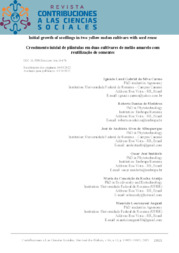Initial growth of seedlings in two yellow melon cultivars with seed reuse.
Initial growth of seedlings in two yellow melon cultivars with seed reuse.
Author(s): CARMO, I. L. G. da S.; MEDEIROS, R. D. de; ALBUQUERQUE, J. de A. A. de; SMIDERLE, O. J.; ARAÚJO, M. da C. da R.; AUGUSTI, M. L.; SILVA, D. C. V. da; SILVA, C. M.
Summary: Farmers adopt sowing in melon seedling production using hybrid seeds, which increases production costs, making crop management more expensive. At the same time, small producers reduce these costs by reusing seeds over successive generations. The objective of this study was to evaluate the physiological quality of seeds from two yellow melon cultivars across two generations based on the initial growth components of the seedlings. A 2 x 2 factorial experiment was tested (2 yellow melon cultivars (cv. Gladial and Gold Mine) × 2 generations -F1 and F2), using 5 replicates with 20 seeds per replicate, totaling 100 plants. To determine the physiological quality of the seeds, the following measurements were made: dry mass of the aerial part (g per plant), height of the aerial part (cm), stem diameter (cm), dry root mass (g per plant), germination percentage (%), seedling emergence (%), speed of emergence (index), abnormal seedlings (%) and non-viable seeds (%). The variable values were subjected to analysis of variance with the application of theF-test at the 5% probability level. The cultivars influence the dry mass of the root, emergence percentage, and emergence speed index. The results obtained from the generations show negative effects on various variables, mainly on unviable and abnormal seeds, due to the attack of phytopathogenic fungi. The Gold Mine cultivar presents seeds of better physiological quality and are more vigorous.
Publication year: 2023
Types of publication: Journal article
Unit: Embrapa Roraima
Observation
Some of Embrapa's publications are published as ePub files. To read them, use or download one of the following free software options to your computer or mobile device. Android: Google Play Books; IOS: iBooks; Windows and Linux: Calibre.
Access other publications
Access the Agricultural Research Database (BDPA) to consult Embrapa's full library collection and records.
Visit Embrapa Bookstore to purchase books and other publications sold by Embrapa.

